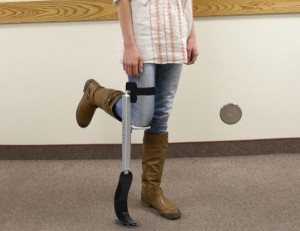Mike Sanders saw a poster of an amputee running on a prosthetic blade in early 2011, and rather than passing by he had an epiphany — why are people still using crutches and scooters for temporary injuries?
One barrier: A prosthetic is generally between $8,000 and $10,000.
But for Sanders, a mechanical engineering student at BYU, the engineering barriers that lead to those figures are simply opportunities. So he set about to design short-time-use prosthetics for about one tenth that price.

“The challenge at that point was to take that concept (of a prosthetic) and bring that level of functionality to a temporary injury,” Sanders said.
By April 2011, Sanders had started working on ideas for a temporary injury prosthetic device, called FlexLeg, and began prototyping the new technology. The tool uses prosthetic technology at its base, allowing free use of the leg — almost just as if the person hadn’t been injured. Using its shock absorbers, FlexLeg users can place their entire weight on that leg and free up their hands — even to play catch in the backyard, albeit somewhat carefully. The company is still a small startup — currently it’s just Sanders and one co-worker, Gianni Santamaria — but distributors and retailers from all over the world have shown interest in the device.
“We hope to ship throughout the continental United States and Hawaii and then expand our base from there. Within a year we want to be in Canada, Europe, New Zealand, Asia, South America,” Santamaria said.
Sanders and Santamaria also have ideas for other products but for now are focusing their efforts on launching FlexLeg.
Sanders said that while starting from scratch has been a major business risk for the startup company, the idea itself has made it worthwhile.
“I’ve dedicated two years of my life to it and risked some things to do it. I believe in the idea, but I also know that there are some ideas out there that should be on the market, but for a variety of reasons, they’re not,” Sanders said.
The business begins shipping its product out July 15.




